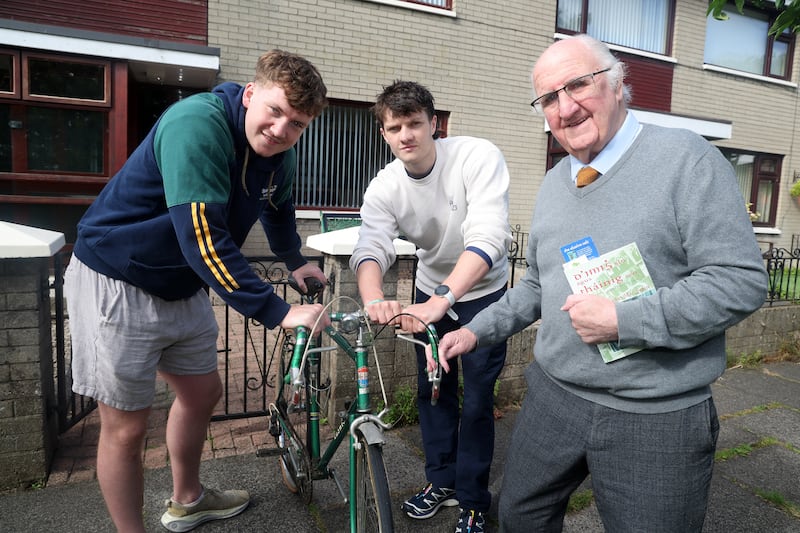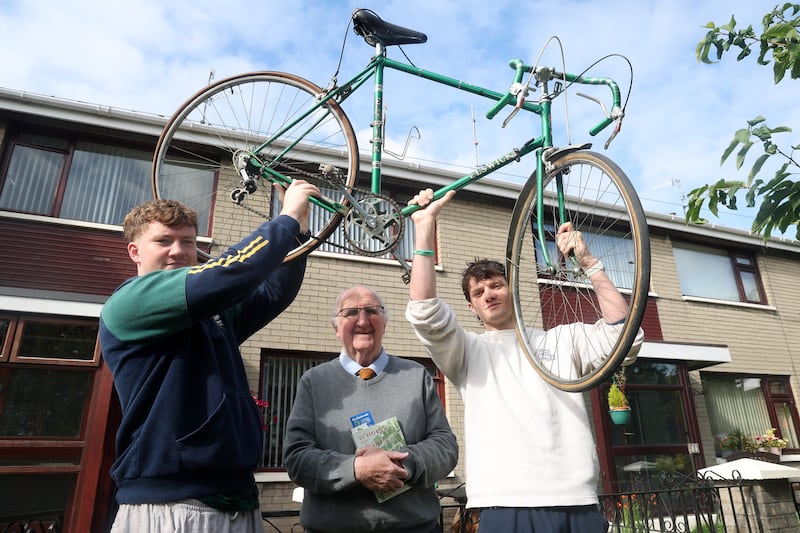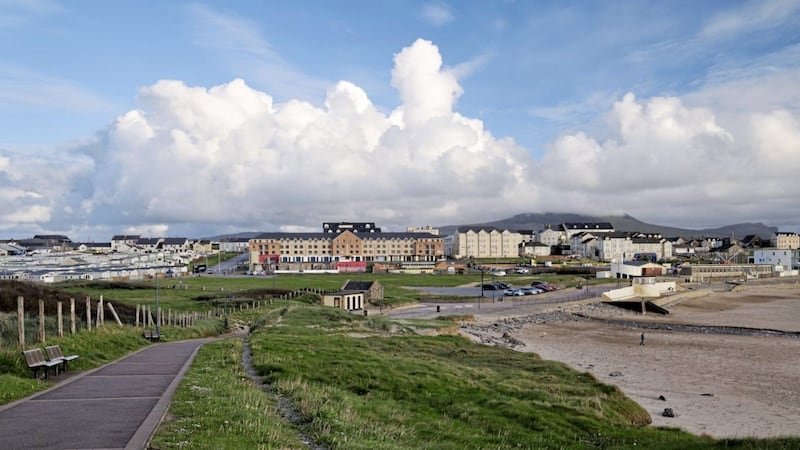A commemorative bike tour retracing the routes of a forgotten cycling club,, which helped drive the Irish language revival will take place as part of this year’s Féile an Phobail.
Organised by Spórtlann na hÉireann’s GaelStair project, the tour will follow a trail laid out by a Belfast cycling club founded by Irish speakers more than 50 years ago.
Speaking to The Irish News, Michael Jackson, project coordinator of GaelStair, said the tour aims to celebrate a generation of activists who sought to infuse the Irish language into everyday life.
“It wasn’t just about the Irish language being taught in the classroom.
 Oisín Ó Ceallaigh, Seán Mac Seáin, Joe McNally with one of the orginal bikes that used by An Cumann Rothaíocht in the 1960’s. PICTURE: MAL MCCANN
Oisín Ó Ceallaigh, Seán Mac Seáin, Joe McNally with one of the orginal bikes that used by An Cumann Rothaíocht in the 1960’s. PICTURE: MAL MCCANN
“As important as that was, they also had things like cycling clubs, swimming clubs, arts clubs, drama clubs – all of these social initiatives that would create conditions to allow people to live their lives through Irish. That’s really where the idea for the bike ride came from.”
The original bike club was founded by members of An Cumann Chluain Árd, an Irish language club which has been involved in teaching the language to people from all areas of Belfast since 1936.
Read more: How a Belfast community used theatre to heal, unite, and inspire
The original bike club was founded by members of An Cumann Chluain Árd
“They were effectively activists who worked to bring the Irish language into the working-class districts of Belfast,” Michael explained.
From this movement came An Cumann Rothaíocht (The Cycling Association) in the 1960s.
“Based on the old photos we’ve seen, it looks like they travelled all over the country,” he added.
“But what’s really fascinating about the club is that it wasn’t just about getting on your bike and having a nice day out, it was deeply tied to the Irish language.
“The club would’ve produced a small paper which would have had the names of various towns and townlands and places where they’d been, as well as things like bike manuals all written and published in Irish.
“So, there was a lot more going on than there usually is in your standard bike club.”
To emulate the club’s historic connection to the Irish language, the tour will take cyclists on a journey through the history of the revival, while immersing them in landscapes and stories enjoyed by generations.
“We’ll be stopping off at various spots and meeting with some of the people involved in the original Cumann Rothaíocht who will be able to tell the guys on the tour about their memories of the bike club when it was first founded.
 Oisín Ó Ceallaigh, Seán Mac Seáin, Joe McNally with one of the orginal bikes that used by An Cumann Rothaíocht in the 1960’s. PICTURE: MAL MCCANN
Oisín Ó Ceallaigh, Seán Mac Seáin, Joe McNally with one of the orginal bikes that used by An Cumann Rothaíocht in the 1960’s. PICTURE: MAL MCCANN
“It’s a nice synergy and way to engage people in the history and heritage of the Irish language community.
“Some people are interested in lectures, classes and talks but for other people who want to get involved with the Irish language it is things like cycling, sports or drama that they connect with.
“And we want to provide as many opportunities for everyone to get involved with the language and in engage with the history as we can.”
Michael adds that the lasting impact of groups like An Cumann Rothaíocht cannot be underestimated.
“A really good example of the influence the club has had is Seán Mistéil who is the director of Spórtlann na hÉireann,” he explains.
“He’s a first-generation Bóthar Seoighe so he was raised in the Shaw’s Road Gaeltacht, and his uncles were part of the original bike club, and through them Seán developed a love of cycling as well.
“So much so that when he was a teenager he cycled roughly around 120 miles from Belfast to Gweedore.
“And when we were setting up for this event, he found the bike he rode there on in his attic – it just goes to show how things like this can help to shape the next generation.”
Speaking on the event Seán said the cycling club was and is a historic example of the “determination to socialise and to live life through Irish”.
“This novel and engaging bike tour is a celebration of a generation of activists who tried to infuse the Irish language into everyday life.”
“Through GaelStair and Spórtlann na hÉireann we hope to revive the connection people have to the Irish language in all aspects of their lives, whether they are into history, literature, music or even sports like cycling.”
Read more: The forgotten village beneath Cave Hill: how Whitewell’s story has been brought back to life
An Cumann Rothaíocht (The Cycling Association) was formed in the 1960s
Setting out from Hawthorn Street on Saturday, August 9, at 10am, the tour will travel through Belfast’s Gaeltacht Quarter towards Shaw’s Road Gaeltacht and up to Colin Glen, taking just over an hour to complete.
Organised bilingually and open to Irish speakers and learners alike, Michael believes events like these are “critical” in preserving the Irish language community in the north.
“This isn’t just a commemoration of the past – it can also help shape our future.
“We think there are some invaluable lessons to be found in the history of the Irish language community in terms of how they socialised the language and how they used it as a vehicle for progressive activism in many forms.
“So we want to celebrate that legacy and hopefully use it to drive the Irish language forward and improve the lives of the community around us.”


